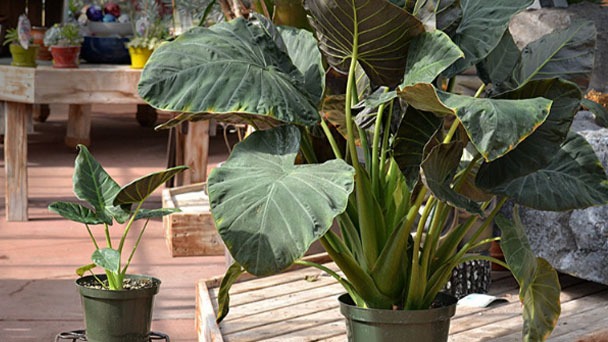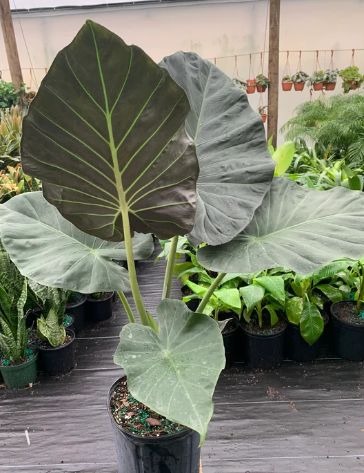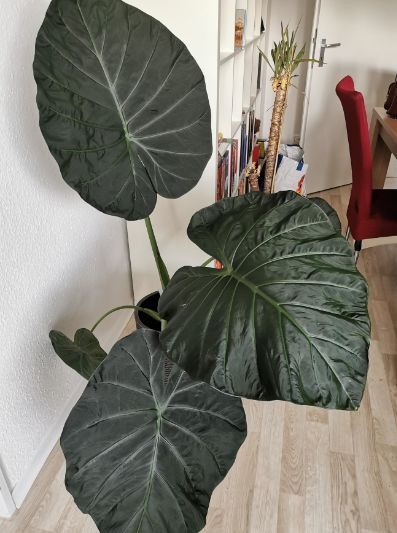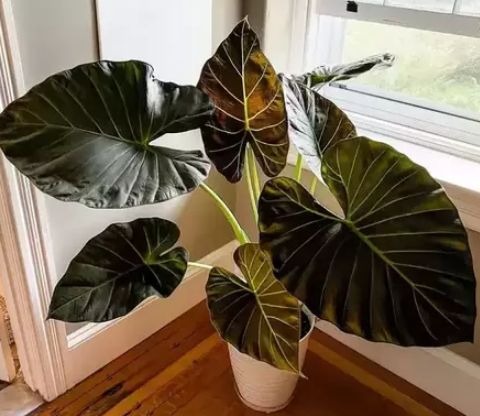Alocasia Regal Shield Care - The Ultimate Guide (2023)
Written by Ivy
Jan 09 2023

The ideal growing conditions for this Regal Shield plant include loamy, acidic soil, letting the top inch of soil dry between waterings, bright indirect sunlight, and temperatures between 68 and 77 degrees Fahrenheit.
Despite the fact that it can grow quite tall very quickly, Alocasia Regal Shield care is low-maintenance. The best location for the Regal Shield Alocasia is a corner or an open wall with plenty of direct sunlight for this plant to grow tall and wide.
Quick Care Overview
| Common Name | Elephant Ear |
| Scientific Name | Alocasia Regal Shield |
| Family | Araceae |
| Origin | Hybrid Cultivar developed in Florida |
| Growth Rate | Medium to fast |
| Identification | Deep black/green leaves on stalk-like petioles |
| Height | Up to 5 feet tall |
| Soil | Loamy, rich, acidic soil that drains well |
| Water | Allow top inch to dry before rewatering |
| Temperature | 65-86F |
| Sunlight | Bright indirect light |
| Toxic to Cats & Dogs | Yes |
| Toxic to Humans | Yes |
| Pests | Aphids, mealybugs, scale, spider mites, thrips |
| Diseases | Powdery mildew, sooty mold, bacterial leaf spot, leaf blight, phyllosticta leaf spot, root rot |
Alocasia Regal Shield Care
The Alocasia Regal Shield is resistant to heat and drought, but it is very vulnerable to cold. This elephant ear plant is remarkably low-maintenance and simple to look after, so long as you can give it high humidity, healthy soil, and bright light.
Soil
A loamy, rich, acidic soil with good drainage is necessary for Alocasia Regal Shield because it is a heavy feeder. For this plant, a typical potting mixture with perlite additions will do. However, a mixture of perlite, fir bark, and coco coir in a 2:1 ratio would make a better growing medium. In order to add some extra nutrients, additional organic matter, such as compost or worm castings, may be added at a rate of about 10%. Every two to three years, the soil should be changed because this plant consumes a lot of food.
Fertilizer
To support its growth throughout the growing season, the best Alocasia Regal Shield care will require routine feeding. This plant will benefit from a monthly feeding of a liquid fertilizer that has been balanced and dilute. To avoid chemical burn, make sure you adhere to all label instructions. During the winter, avoid feeding your Aloe. Mid-fall, feeding may be stopped.

Watering
This plant prefers a constant moisture level that isn't excessively wet. Before rewatering, let the top inch of soil dry out completely. Rainwater or distilled water are preferred because this plant is sensitive to chemicals in tap water. Wintertime watering needs to be cut back. Too much water will cause an Alocasia's leaves to droop. Alocasias that have been submerged will have wilting leaves.
Light Requirements
This plant prefers strong, indirect light that is up to 85%, like that coming from a west or east-facing window. Avoid placing your plant in the sun's direct path because the sun's scorching rays can seriously harm it. This plant's container should be turned frequently. By turning the container, you can maintain the plant's steady growth and gorgeous foliage as it quickly moves toward the light. If your Alocasia doesn't get enough light, its foliage will become dull.
Temperature & Humidity
Regal Shield Alocasia enjoys heat and humidity because it is a tropical plant. The ideal temperature range is between 68 and 77 degrees Fahrenheit, though it can withstand temperatures as high as 86 degrees. Never allow the temperature of your plant to drop below 60 degrees Fahrenheit as this could result in long-term damage. High relative humidity is ideal for Regal Shield's growth; it should never fall below 60%. It is advised to frequently mist the leaves or use a pebble tray or humidifier.
Repotting
This plant can easily become top-heavy, so it's important to choose a heavy container for potting that has plenty of room for the roots to breathe. Choose a pot that is 1-2 inches bigger than the prior pot, and make sure it has enough drainage holes. Every two years, repotting should be performed.
Pruning
Late winter to early spring is the ideal time to prune. Remove any diseased, discolored, or damaged leaves with sterile shears. Dusting can help maintain the luster of foliage.
Alocasia Regal Shield Propagation
Root division makes it simple to spread the Alocasia Regal Shield. This particular Alocasasia is known to have numerous offshoots growing from the mother plant, which may be divided and replanted into their own container. The best times to propagate plants are in the spring or summer when they are actively growing. Remove the mother plant's root ball and some soil before starting a new plant to propagate. After that, use your hands to gently separate some of the clumps. The clumps should then be planted in their own container, the soil should be refreshed, it should be thoroughly watered, and indirect light should be provided.
- The best time to propagate is early spring, early in the growing season.
- Propagation stresses out your plant in the same way that repotting does. So, only attempt propagation when you have a healthy and mature plant.
- Don't propagate if you have a new plant or recently relocated it.
Propagation through Root (Clump) Division
- Water your plant and sterilize a knife blade with 70% isopropyl solution the day before you plan to propagate it.
- Unpot your Alocasia Regal Shield and flip your plant over. To see the rhizomes, roots, and petioles, gently tease out the soil with your fingers. Keep the roots intact at all costs.
- Slice through the rhizome with the sterilized blade to separate the pup from the mother plant. Make sure the pup that was separated has established roots and petioles.
- The pup needs to be repotted in moist potting soil. Select a pot with drainage holes that is large enough to accommodate the pup's roots and rhizome as well as its size.
- Place the mother plant's pot back in the ground.
- Maintain a warm, humid environment for both plants with lots of indirect light. If you have a humidifier, put it next to the plants and set the humidity level to 80%.
- Root development in the baby plant and the recovery of your mother plant will both take about 3–4 weeks. While this is happening, your plants might exhibit signs of stress.
- Your plants' recovery is evidenced by new growth!

Propagation by Offsets
- Use a clean cut with a sterilized knife to separate the mother plant from the offset by cutting at the base of the stem.
- Replant the offset in a potting soil that is evenly moist. In a few weeks, it will begin developing its own roots.
- Make sure to keep both plants in a warm, humid environment with plenty of indirect light. If you have a humidifier, put it close to the plants and set the humidity level to 80%.
- Both plants might exhibit some signs of stress, but they will get better in a few weeks.
Propagation by Bulb Harvesting (sometimes Called Corms)
Bulb harvesting is another method of propagating your Alocasia Regal Shield. The development of a new plant takes longer when it comes from a bulb, of course.
- Two days before propagation, water your plant.
- With care to prevent damaging its roots, remove your plant from its container.
- Take out any extra soil so you can look at the roots of your plant. Several bulbs are frequently hidden beneath the ground and entangled in the roots.
- When choosing mature bulbs, look for ones that are thick, round, hard, and easy to pull away from the roots. In an established plant, you should be able to find 5–10 mature bulbs.
- Separately, plant each bulb in a brand-new pot filled with new soil, root side down.
- Back into the original container, repot your mother plant.
- Water both plants.
- After being divided and replanted, you should anticipate that your mother plant will exhibit some signs of stress. Wait a few weeks and watch your mother plant heal.
- A successful propagation is indicated by new growth!
Alocasia Regal Shield Toxicity
This plant is thought to be toxic to both people and animals because it contains calcium oxalate crystals. If you handle this plant, always wash your hands.
Toxicity to Humans
This plant is regarded as harmful to people. Ingestion may also result in a variety of GI problems or mouth irritation.
Toxicity to Cats & Dogs
Pets are thought to be toxic to Alocasia Regal Shield, so it must never be consumed. Contact animal poison control or your veterinarian right away if you think your pet may have consumed any part of this plant.
Alocasia Regal Shield History
A hybrid cultivar, Alocasia Regal Shield is a cross between Alocasia Reginula and Alocasia Odora. This Alocasia, also known as the "Elephant Ear," was created in Florida and, when grown under ideal conditions, makes a stunning houseplant or addition to an outdoor garden. The black velvety heart-shaped foliage of this plant, which also has air-purifying properties, almost has a magical aesthetic.
Alocasia Regal Shield Identification
On upright, stalk-like petioles that can reach a maximum length of 20 inches, this Alocasia's leaves are a dark, oxidized green. Regal Shield, like many Alocasias, has typical heart-shaped leaves with ruffled edges and red undersides.
Alocasia Regal Shield Growth Facts
Alocasia Regal Shield is a sizable indoor plant that can quickly reach the ceiling. Although this plant may not be appropriate for small spaces, it will make a fantastic display plant for a patio or sizable living space. Due to its broad spread and large foliage, this plant can reach heights of over 5 feet.

Alocasia Regal Shield Problems
Alocasia Regal Shield Leaves Turning Yellow
Lack of drainage, excessive watering, overfertilization, or chemicals in tap water can all cause the foliage to turn yellow. Provide well-draining soil and use rainwater or distilled water.
Alocasia Regal Shield Leaves Turning Brown
It's likely that bacterial or fungal disease is the cause of any brown spots on the foliage. It is advisable to remove any damaged foliage and to use less water. When watering, be careful not to wet the foliage. In contrast, a deficiency in humidity may be the cause of crisped brown edges.
Alocasia Regal Shield Diseases
Alocasia Regal Shield may be afflicted by a number of bacterial and fungal diseases, such as powdery mildew, sooty mold, bacterial leaf spot, leaf blight, root rot, or phyllosticta leaf spot. Check to see that the drainage tray is not overflowing with water and that your plant has adequate drainage. In the event that a disease is discovered, cut off the affected roots and foliage and repot the plant. To combat the illness, fungicide may be used. Make sure you adhere to the label's instructions.
Alocasia Regal Shield Pests
Numerous pest problems are possible with this Alocasia. This elephant ear plant may become troubled by aphids, mealybugs, scale, spider mites, and thrips. If you find an infestation, isolate the plant and use a pesticide according to the label's directions.
FAQs
Can Regal Shield Alocasia Take Full Sun?
Bright indirect sunlight is required for Alocasia Regal Shield. The foliage burns in direct or full sunlight.
When Should I Repot My Regal Shield?
In order to give the roots of Alocasia Regal Shields new, aerated soil, they must be repotted every two years.
Conclusion
The preferred conditions for Alocasia Regal Shield are indirect sunlight, temperatures between 65 and 75 °C, and humidity levels above 70%. They favor soil that is rich in organic matter and is both moist and well-draining. To encourage wholesome growth in the spring and summer, apply a balanced fertilizer once a month.
If you follow the right care instructions, it won't take long for the plant to reach its full size. If you want a mix of aesthetic and tropical looks, you must have the alocasasia regal shield plant.
Latest Updated
- Benefits of Bugleweed - 7 Science-backed Health Benefits
- Bugleweed Dangers & Side Effects - Is It Poisonous?
- How to Plant Evergreen Trees - What You Should Know
- When to Plant Evergreens - Grow Guide for Evergreen Trees
- 12 Wonderful Evergreen Shrubs for Your Garden
- 12 Popular Evergreen Plants with Pictures for Beginners
- When And How To Prune A Lilac Bush Like a Pro
- How to Grow & Care for Lilac Vine (Hardenbergia Violacea)
- Japanese Lilac Tree (Syringa Reticulata) Care & Propagation Guide
- Shumard Oak Pros and Cons - What to Know
Popular Articles
- Winter maintenance of Antirrhinum Majus
- How to Grow Terminalia Mantaly Tree
- How to Grow and Care for Crossostephium Chinense
- How to grow Antirrhinum Majus in spring
- Peristeria Elata (Dove Orchid) Profile: Info & Care Guide
- Underwatered Snake Plant (Sansevieria Trifasciata) - Signs And How To Fix
- How to Care for Brazilian Jasmine Plant (Mandevilla Sanderi)
- How to Grow & Care for Graptopetalum Purple Delight in Summer
- Rosa Chinensis (China Rose): Plant Growing & Care Tips
- How to Care for Baby Sun Rose (Aptenia Cordifolia)